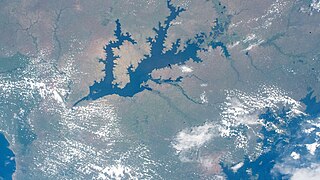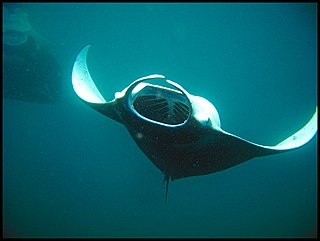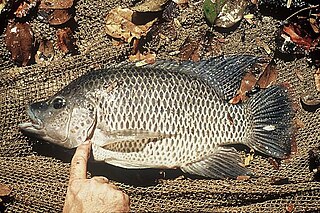Related Research Articles

Zambia is a landlocked country located in Southern Africa, to the east of Angola. It has a total area of 752,618 square kilometres, of which 9 220 km2 is water.

The Zambezi is the fourth-longest river in Africa, the longest east-flowing river in Africa and the largest flowing into the Indian Ocean from Africa. Its drainage basin covers 1,390,000 km2 (540,000 sq mi), slightly less than half of the Nile's. The 2,574-kilometre-long (1,599 mi) river rises in Zambia and flows through eastern Angola, along the north-eastern border of Namibia and the northern border of Botswana, then along the border between Zambia and Zimbabwe to Mozambique, where it crosses the country to empty into the Indian Ocean.

Lake Kioga or Lake Kyoga is a large shallow lake in Uganda, about 1,720 km2 (660 sq mi) in area and at an elevation of 1,033 metres. The Victoria Nile flows through the lake on its way from Lake Victoria to Lake Albert. The main inflow from Lake Victoria is regulated by the Nalubaale Power Station in Jinja. Another source of water is the Mount Elgon region on the border between Uganda and Kenya. While Lake Kyoga is part of the African Great Lakes system, it is not itself considered a great lake.
Kariba is a resort town in Mashonaland West province, Zimbabwe, located close to the Kariba Dam at the north-eastern end of Lake Kariba, near the Zambian border. According to the 2022 Population Census, the town had a population of 27,600.

Lake Kariba is the world's largest artificial lake and reservoir by volume. It lies 1,300 kilometres (810 mi) upstream from the Indian Ocean, along the border between Zambia and Zimbabwe. Lake Kariba was filled between 1958 and 1963 following the completion of the Kariba Dam at its northeastern end, flooding the Kariba Gorge on the Zambezi River.

The Tanganyika sardine is two species, both of which are small, planktivorous, pelagic, freshwater clupeid originating from Lake Tanganyika in Zambia. They form the major biomass of pelagic fish in Lake Tanganyika and Lake Malawi, swimming in large schools in the open lake, feeding on copepods and potentially jellyfish. Their major predators are four species of Lates which are also endemic to Lake Tanganyika, and are related to the Nile perch in Lake Victoria. All of these pelagic fish have suffered from overfishing in the last two decades.
Freshwater ecosystems are a subset of Earth's aquatic ecosystems. They include lakes, ponds, rivers, streams, springs, bogs, and wetlands. They can be contrasted with marine ecosystems, which have a larger salt content. Freshwater habitats can be classified by different factors, including temperature, light penetration, nutrients, and vegetation. There are three basic types of freshwater ecosystems: Lentic, lotic and wetlands. Freshwater ecosystems contain 41% of the world's known fish species.
Global change in broad sense refers to planetary-scale changes in the Earth system. It is most commonly used to encompass the variety of changes connected to the rapid increase in human activities which started around mid-20th century, i.e., the Great Acceleration. While the concept stems from research on the climate change, it is used to adopt a more holistic view of the observed changes. Global change refers to the changes of the Earth system, treated in its entirety with interacting physicochemical and biological components as well as the impact human societies have on the components and vice versa. Therefore, the changes are studied through means of Earth system science.

The Tonga people of Zambia and Zimbabwe are a Bantu ethnic group of southern Zambia and neighbouring northern Zimbabwe, and to a lesser extent, in Mozambique. They are related to the Batoka who are part of the Tokaleya people in the same area, but not to the Tonga people of Malawi. In southern Zambia they are patrons of the Kafue Twa. They differ culturally and linguistically from the Tsonga people of South Africa and southern Mozambique.

The Lake Tanganyika sardine is a species of freshwater fish in the family Dorosomatidae which was endemic to Lake Tanganyika but which has now been introduced to other lakes in Africa as a food source. It is monotypic within the genus Limnothrissa. It and the Lake Tanganyika sprat are known collectively as kapenta.
Gorgonin is a complex protein that makes up the horny skeleton of the holaxonia suborder of gorgonians. It frequently contains appreciable quantities of bromine, iodine, and tyrosine.

Hydrobiologia, The International Journal of Aquatic Sciences, is a peer-reviewed scientific journal publishing 21 issues per year, for a total of well over 4000 pages per year. Hydrobiologia publishes original research, reviews and opinions investigating the biology of freshwater and marine habitats, including the impact of human activities. Coverage includes molecular-, organism-, community -and ecosystem-level studies dealing with biological research in limnology and oceanography, including systematics and aquatic ecology. In addition to hypothesis-driven experimental research, it presents theoretical papers relevant to a broad hydrobiological audience, and collections of papers in special issues covering focused topics.

Biomphalaria sudanica is a species of air-breathing freshwater snail, an aquatic pulmonate gastropod belonging to the family Planorbidae, the ram's horn snails. Biomphalaria sudanica has a discoidal, brown shell with an approximate shell diameter of 9–11mm. Biomphalaria sudanica is a medically important pest, due to it being an intermediate host of the intravascular trematode genus, Schistosoma.
PCLake is a dynamic, mathematical model used to study eutrophication effects in shallow lakes and ponds. PCLake models explicitly the most important biotic groups and their interrelations, within the general framework of nutrient cycles. PCLake is used both by scientist and water managers. PCLake is in 2019 extended to PCLake+, which can be applied to stratifying lakes.
Biomanipulation is the deliberate alteration of an ecosystem by adding or removing species, especially predators.

A planktivore is an aquatic organism that feeds on planktonic food, including zooplankton and phytoplankton. Planktivorous organisms encompass a range of some of the planet's smallest to largest multicellular animals in both the present day and in the past billion years; basking sharks and copepods are just two examples of giant and microscopic organisms that feed upon plankton. Planktivory can be an important mechanism of top-down control that contributes to trophic cascades in aquatic and marine systems. There is a tremendous diversity of feeding strategies and behaviors that planktivores utilize to capture prey. Some planktivores utilize tides and currents to migrate between estuaries and coastal waters; other aquatic planktivores reside in lakes or reservoirs where diverse assemblages of plankton are present, or migrate vertically in the water column searching for prey. Planktivore populations can impact the abundance and community composition of planktonic species through their predation pressure, and planktivore migrations facilitate nutrient transport between benthic and pelagic habitats.
Michael Ghil is an American and European mathematician and physicist, focusing on the climate sciences and their interdisciplinary aspects. He is a founder of theoretical climate dynamics, as well as of advanced data assimilation methodology. He has systematically applied dynamical systems theory to planetary-scale flows, both atmospheric and oceanic. Ghil has used these methods to proceed from simple flows with high temporal regularity and spatial symmetry to the observed flows, with their complex behavior in space and time. His studies of climate variability on many time scales have used a full hierarchy of models, from the simplest ‘toy’ models all the way to atmospheric, oceanic and coupled general circulation models. Recently, Ghil has also worked on modeling and data analysis in population dynamics, macroeconomics, and the climate–economy–biosphere system.

Oreochromis mortimeri, the Kariba tilapia or kurper bream, is a species of cichlid, formerly classified as a Tilapiine cichlid but now placed in the genus Oreochromis, the type genus of the tribe Oreochromini of the subfamily Pseudocrenilabrinae. It is found in the rivers of south central Africa especially the middle Zambezi where it is endangered by the spread of invasive congener Oreochromis niloticus.
Italian Zimbabweans are citizens or residents of Zimbabwe of Italian heritage. The phrase may refer to someone born in the Zimbabwe of Italian descent, someone who has emigrated from Italy to Zimbabwe, a person with Italo-Zimbabwean heritage or someone born elsewhere, who is of Italian descent and has migrated to Zimbabwe. Italian Zimbabweans form one of the younger communities of the Italian diaspora, largely a product of wartime and post-war immigration.

Heinz Wanner is a Swiss geographer and climate researcher. He is a professor emeritus and works at the Oeschger Centre for Climate Change Research of the University of Bern.
References
- ↑ 1:250,0000 Series: Kariba (Map) (1998 ed.). Surveyor General, Zimbabwe.
- ↑ Sanyanga, R.A. (2004). "Food composition and selectivity of Synodontis zambezensis (Pisces: Mochokidae) in Lake Kariba, and the ecological implications". Hydrobiologia. Berlin: Springer-Verlag. 361: 89–99. doi:10.1023/A:1003101813361. S2CID 22947633.
- ↑ Hustler, K.; Marshall, B.E. (1990). "Population dynamics of two small cichlid fish species in a tropical man-made lake (Lake Kariba)". Hydrobiologia . Berlin: Springer-Verlag. 190 (3): 253–262. doi:10.1007/BF00008193. S2CID 12993968.
- ↑ Magadza, C.H.D. (2000). "Climate Change Impacts and Human Settlements in Africa: Prospects for Adaptation". Environmental Monitoring and Assessment. Berlin: Springer-Verlag. 61: 193–205. doi:10.1023/A:1006355210516. S2CID 93006047.